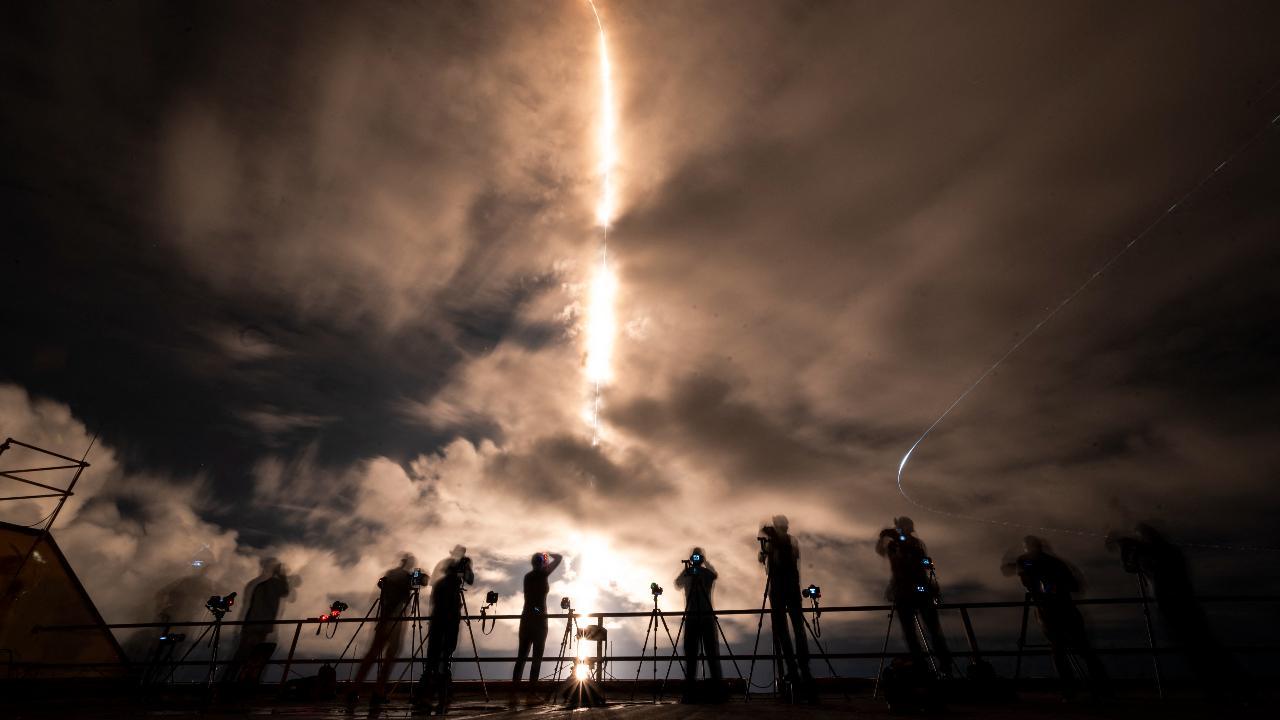The SpaceX Polaris Dawn mission launched Tuesday from the Kennedy Space Center in Florida, journeying deeper into the cosmos than any humans in half a century

A SpaceX Falcon 9 rocket with the Crew Dragon Resilience capsule, carrying the crew of the Polaris Dawn Mission, lifts off from Kennedy Space Center, Florida, on September 10, 2024 (Pic: AFP)
A pioneering private crew made history Thursday by performing the first commercial spacewalk, with NASA hailing it as "a giant leap forward" for the space industry.
ADVERTISEMENT
The SpaceX Polaris Dawn mission, led by fintech billionaire Jared Isaacman, launched Tuesday from the Kennedy Space Center in Florida, journeying deeper into the cosmos than any humans in half a century, since the Apollo era.
With the four-member crew's Dragon spacecraft adjusted to an orbit with a high of 434 miles (700 kilometers), pure oxygen began flowing into their suits Thursday, marking the official start of their extravehicular activity (EVA) at 1012 GMT.
A short time later, Isaacman swung open the hatch and climbed through, gripping the hand and footholds of a structure known as "Skywalker," as a breathtaking view of Earth unfolded below him.
"SpaceX, back at home we all have a lot of work to do, but from here, Earth sure looks like a perfect world," he told mission control in Hawthorne, California, where teams erupted in applause.
It was yet another major milestone for SpaceX, the company founded by Elon Musk in 2002. Since then, SpaceX has grown into a powerhouse that in 2020 beat aerospace giant Boeing in delivering a spaceship to provide rides for NASA astronauts to the International Space Station.
"Today's success represents a giant leap forward for the commercial space industry and NASA's long-term goal to build a vibrant US space economy," NASA chief Bill Nelson wrote on X.
Suit tests
Prior to the hatch opening, the crew underwent a "prebreathe" procedure to remove nitrogen from their bloodstream, preventing decompression sickness. Cabin pressure was then gradually lowered to align with the vacuum of space.
Isaacman and crewmate Sarah Gillis, a SpaceX engineer, took turns outside the vehicle, spending a few minutes performing mobility tests on SpaceX's next-generation suits that boast heads-up displays, helmet cameras and enhanced joint mobility systems -- before returning inside.
Extravehicular activity officially ended after an hour and 46 minutes, following cabin repressurization.
While it marked a first for the commercial sector, the spacewalk fell short of the daring feats from the early space era. Early spacewalkers, including the first, Soviet cosmonaut Alexei Leonov in 1965, floated tethered to their spacecraft, while a select few Space Shuttle astronauts used jetpacks to fly completely untethered.
Since Dragon doesn't have an airlock, the entire crew were exposed to the vacuum of space. Mission pilot Scott Poteet and SpaceX engineer Anna Menon remained strapped in throughout as they monitored vital support systems.
"The risk is greater than zero, that's for sure, and it's certainly higher than anything that has been accomplished on a commercial basis," former NASA administrator Sean O'Keefe told AFP.
First of three Polaris missions
The spacewalk followed an audacious first phase of the mission, during which the Dragon spacecraft reached a peak altitude of 870 miles -- three times higher than the International Space Station, in a region teeming with dangerous, high-energy particles.
All four underwent more than two years of training in preparation for the landmark mission, logging hundreds of hours on simulators as well as skydiving, scuba diving and summiting an Ecuadoran volcano.
Upcoming tasks include testing laser-based satellite communications between the spacecraft and the vast Starlink satellite constellation, and completing dozens of experiments, including tests on contact lenses with embedded microelectronics to monitor changes in eye pressure and shape in space.
Polaris Dawn is the first of three missions under the Polaris program, a collaboration between Isaacman and SpaceX.
This story has been sourced from a third party syndicated feed, agencies. Mid-day accepts no responsibility or liability for its dependability, trustworthiness, reliability and data of the text. Mid-day management/mid-day.com reserves the sole right to alter, delete or remove (without notice) the content in its absolute discretion for any reason whatsoever
 Subscribe today by clicking the link and stay updated with the latest news!" Click here!
Subscribe today by clicking the link and stay updated with the latest news!" Click here!







